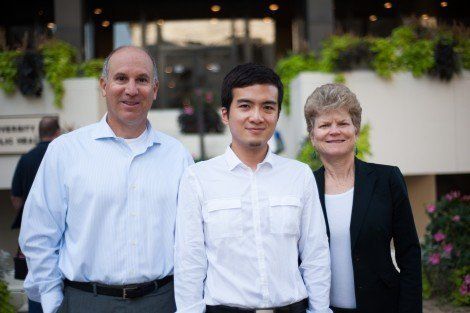Spread of tainted food products highlights need to strengthen global food safety
October 15, 2013 – In fall 2011, Chih Chao “Justin” Yang, MPH ’12, a physician pursuing a career in internal medicine, had an idea for his 1,000-word final project for [[Rose Goldman]]’s EH201, Introduction to Environmental Health class.
With a strong interest in preventive medicine, Yang wanted to increase awareness of the need for governments to stop illegal food manufacturing practices and tighten food safety regulations. He wanted classmates to learn about a Taiwan incident earlier that year in which manufacturers reportedly tried to cut costs by replacing palm oil with two phthalates (chemicals added to plastics to increase flexibility). The chemicals, including one known as DEHP, had been added to nearly 1,000 food products – including sports drinks, tea, juice, dietary supplements, and jam – and exported to 22 countries, including the U.S. and Canada. He believed the incident, which wasn’t widely publicized in the U.S., demanded further disclosure and investigation.
“I was curious and wanted to know what kind of health effects DEHP might have on people if they ate tainted foods and beverages every day,” he said. DEHP can affect hormones and has been linked to developmental issues in children and reproductive organ development problems in male laboratory animals. After the Taiwan government made public the tainted food, the products were reportedly pulled from market and destroyed. However, according to Yang, the government apparently did not investigate the full extent of contamination or potential health impacts.
The result of his class project was an essay, “DEHP, food safety and prenatal sexual development: Time to mandatory test this antiandrogen.” Goldman, associate professor of environmental health sciences, was impressed with Yang’s paper. “He raised some interesting questions, and I told him it might be worth trying to turn it into a publishable manuscript and I would help him if he wanted,” she said.
Yang took her up on the offer, and he and Goldman arranged an independent study course for spring 2012. “The course included not only getting, translating, and analyzing more of the data with me, but also learning the fundamentals of how to research the literature, organize references, and write a manuscript,” Goldman said. She invited [[Russ Hauser]], Frederick Lee Hisaw professor of reproductive physiology at HSPH, who studies phthalates, to join the endeavor. “Russ contributed very welcomed input. Justin worked very hard on this project, showing intelligence and perseverance,” Goldman said.
In May 2013 Yang found out that Food and Chemical Toxicology had accepted the manuscript. “I was very happy because publishing this paper not only showed what I’ve learned as a MPH student–the perspective from a public health viewpoint–but it gave me the chance to raise awareness of the importance of food safety and possibly stir up some conversation about strengthening current food safety regulations,” Yang said.
In the paper, “Taiwan food scandal: The illegal use of phthalates as a clouding agent and their contribution to maternal exposure,” which was published in August, Yang and his colleagues reviewed news reports in Asian media that listed possible contaminated products, analyzed DEHP concentration reports from the Taiwan government website, and translated into English the names of 28 of the tainted products. They estimated that, for a 110-pound pregnant woman drinking one 500-ml bottle (about 16 ounces) per day of tainted sports drink would result in an average DEHP intake 4.5–17 times higher than the maximum daily intake recommended by U.S. and European guidelines, raising concerns about possible harm to fetuses.
“We were the first to report levels of contamination in detail, and to provide an understanding of what kind of health effects those levels of contamination could have. No prior published study discussed in detail the tainted concentration levels vs. the guidelines,” Yang said.
Yang hopes the study findings will reach beyond the classroom. “The findings of this paper could be used to urge governments, both in the U.S. and internationally, to establish regulations on imported foods to protect the health of their citizens,” Yang said.
In spring 2012, Goldman recommended Yang to [[Stefanos Kales]], associate professor in the HSPH Department of Environmental Health, who hired him as a postdoctoral research fellow. Yang has been working with Kales on cardiovascular disease risk factor screening and prevention studies in firefighters, has published two more papers, and is working on a third. He soon hopes to begin a follow-up paper on the Taiwan food scandal with Goldman.
Yang is finishing the three stages of the U.S. Medical Licensing Exam and is applying for residency in the U.S.
Goldman said Yang has turned into a skilled and creative researcher. “We plant a lot of seeds in our introductory environmental health courses, and some really bloom and flower,” she said.
photo: Emily Cuccarese
